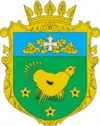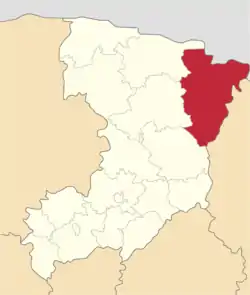Rokytne Raion, Rivne Oblast
Rokytne Raion (Ukrainian: Рокитнівський район) was a raion in Rivne Oblast in western Ukraine. Its administrative center was the urban-type settlement of Rokytne. The raion was abolished on 18 July 2020 as part of the administrative reform of Ukraine, which reduced the number of raions of Rivne Oblast to four.[1][2] The last estimate of the raion population was 58,223 (2020 est.)[3]
Rokytne Raion
Рокитнівський район | |
|---|---|
 Flag  Coat of arms | |
 | |
| Coordinates: 51°23′31″N 27°15′39″E | |
| Country | |
| Region | Rivne Oblast |
| Established | 1939 |
| Disestablished | 18 July 2020 |
| Admin. center | Rokytne |
| Subdivisions | List
|
| Area | |
| • Total | 2,350 km2 (910 sq mi) |
| Population (2020) | |
| • Total | 58,223 |
| • Density | 25/km2 (64/sq mi) |
| Time zone | UTC+02:00 (EET) |
| • Summer (DST) | UTC+03:00 (EEST) |
| Area code | +380 |
| Website | http://www.rv.gov.ua/sitenew/rokytnivsk Rokytne Raion |
Demographics
Rokytne Raion was probably the place with the highest birth rate in all of Ukraine. The Raion recorded a birth rate of 24.0 per 1,000 in 2008.[4] The village council of Hlynne is widely regarded as holding the record for the highest birth rate in all of Europe.[5][6][7]
- Births (2011) : 1,304 births at 24.0 per 1,000
- Births (2012) : 1,391 births at 25.9 per 1,000
- Births (2014) : 1,328 births at 24.0 per 1,000
- Births (2016) : 1,177 births at 20.6 per 1,000
- Births (2017) : 1,064 births at 18.5 per 1,000
- Births (2018) : 1,050 births at 18.2 per 1,000
- Deaths (2011) : 615 deaths at 11.3 per 1,000[8]
- Deaths (2012) : 595 deaths at 11.1 per 1,000
- Deaths (2014) : 617 deaths at 11.2 per 1,000
- Deaths (2016) : 607 deaths at 10.6 per 1,000
- Deaths (2017) : 593 deaths at 10.3 per 1,000
- Deaths (2018) : 575 deaths at 10.0 per 1,000
World War 2
On August 26, 1942, after living under a reign of terror for just over a year, the Jews of Rokitno were ordered to gather in the central market square for deportation to a killing site outside the town. When many of them realized what was about to occur, the crowd began to panic. As people began to run, Nazi and Ukrainian police began to shoot. People were systematically shot or herded into waiting rail cars, destined for Sarny.[9] Jews were also forcibly transferred to Sarny from the towns of Tomashgorod, Klesov and Dubrovitsa.[10]
This event is collectively referred to as part of the 1942 Sarny Massacre.
See also
References
- "Про утворення та ліквідацію районів. Постанова Верховної Ради України № 807-ІХ". Голос України (in Ukrainian). 2020-07-18. Retrieved 2020-10-03.
- "Нові райони: карти + склад" (in Ukrainian). Міністерство розвитку громад та територій України.
- "Чисельність наявного населення України (Actual population of Ukraine)" (PDF) (in Ukrainian). State Statistics Service of Ukraine. Retrieved 30 September 2020.
- http://www.oblstat.rivne.com
- http://gazeta.ua/index.php?id=351826&lang=ru
- http://zik.com.ua/ua/news/2009/09/02/194543
- http://www.rivne1.tv/Info/?id=3464
- http://www.rv.gov.ua/sitenew/rokytnivsk/ua/8766.htm
- 7
- 8
[1] Israel Greenberg, "Tearful Events" (Ala Gamulka, trans.). Contained in E. Leoni (ed.), Rokitno-Wolyn and Surroundings; Memorial Book and Testimony. Tel Aviv, 1967.
[2] Shmuel Spector, The Jews of Volhynia and their Reaction to Extermination. Yad Vashem, The Untold Stories: The Murder Sites of The Jews In the Occupied Territories of the Former USSR, pp. 159–186 at p. 161. Retrieved August 25, 2016.